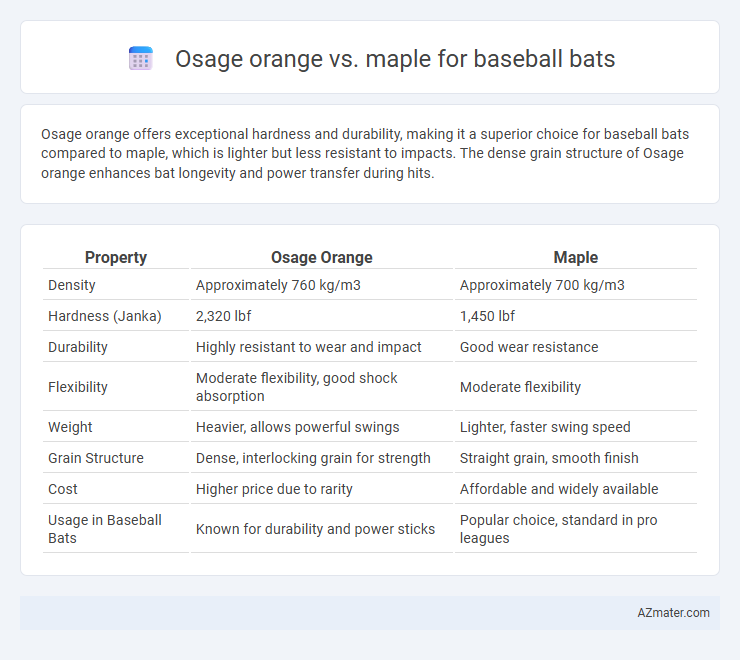Osage orange offers exceptional hardness and durability, making it a superior choice for baseball bats compared to maple, which is lighter but less resistant to impacts. The dense grain structure of Osage orange enhances bat longevity and power transfer during hits.
Table of Comparison
| Property | Osage Orange | Maple |
|---|---|---|
| Density | Approximately 760 kg/m3 | Approximately 700 kg/m3 |
| Hardness (Janka) | 2,320 lbf | 1,450 lbf |
| Durability | Highly resistant to wear and impact | Good wear resistance |
| Flexibility | Moderate flexibility, good shock absorption | Moderate flexibility |
| Weight | Heavier, allows powerful swings | Lighter, faster swing speed |
| Grain Structure | Dense, interlocking grain for strength | Straight grain, smooth finish |
| Cost | Higher price due to rarity | Affordable and widely available |
| Usage in Baseball Bats | Known for durability and power sticks | Popular choice, standard in pro leagues |
Osage Orange vs Maple: An Overview
Osage Orange and Maple are both popular woods for baseball bats, with Osage Orange prized for its exceptional hardness, density, and durability, offering superior impact resistance and longevity compared to Maple. Maple bats provide a slightly lighter weight and a smoother grain structure, allowing for better swing speed and consistent performance. Choosing Osage Orange over Maple can result in a bat that withstands high-velocity hits better but may feel heavier, while Maple offers a balanced combination of strength and lightweight maneuverability for players.
Wood Density and Hardness Comparison
Osage orange wood has a density of approximately 56-64 lbs/ft3, making it significantly denser and harder than maple, which typically has a density around 42-47 lbs/ft3. The Janka hardness rating for Osage orange can reach up to 2,530 lbf, whereas sugar maple, commonly used for baseball bats, scores about 1,450 lbf, indicating Osage orange is much more resistant to dents and wear. This greater density and hardness make Osage orange highly durable and ideal for players seeking long-lasting, impact-resistant baseball bats.
Durability and Longevity in Gameplay
Osage orange baseball bats offer exceptional durability due to their dense, hard wood, resisting dents and cracks during intensive gameplay better than most alternatives. Maple bats, favored in professional leagues, combine strength with a fine grain that enhances longevity but may chip or splinter under repeated high-impact hits. Players seeking a bat with superior lifespan and resistance to wear often prefer Osage orange for its robust performance in sustained use.
Flexibility and Shock Absorption Differences
Osage orange wood offers superior flexibility and shock absorption compared to maple, making it an excellent choice for baseball bats that require enhanced swing control and reduced hand sting. Maple bats, known for their hardness and density, provide less flex and absorb impact shocks less effectively, resulting in a stiffer feel during play. The natural grain structure of Osage orange contributes to its resilience and vibration dampening, which improves overall bat performance and player comfort.
Weight Distribution and Balance
Osage orange baseball bats exhibit a dense, heavy weight distribution that delivers exceptional power and durability, making them ideal for strong hitters seeking maximum impact. Maple bats feature a lighter, more evenly balanced weight profile, enhancing swing speed and control for improved precision at the plate. The choice between Osage orange and maple depends on a player's preference for power versus maneuverability in weight distribution and balance.
Performance and Hitting Power
Osage orange offers exceptional durability and high density, providing superior hitting power and energy transfer compared to maple, which is lighter and slightly less dense. Maple bats deliver a more consistent grain structure, resulting in better control and reduced vibration, enhancing overall performance for precise swings. Players seeking maximum power may prefer Osage orange, while those prioritizing balance and smooth contact often choose maple.
Availability and Cost Factors
Osage orange baseball bats are less common and often more expensive due to the wood's scarcity and slower growth rate compared to maple, which is widely available and popular in bat manufacturing. Maple bats typically offer more consistent pricing and easier replacement options, making them a preferred choice for players seeking affordability and accessibility. The dense, durable nature of Osage orange can justify higher costs but may be harder to find in local markets.
Player Preferences: Pro and Amateur Choices
Osage orange bats are favored by both pro and amateur baseball players for their exceptional hardness and durability, providing a powerful hit and resistance to cracking. Maple bats are preferred for their lighter weight and smooth grain, allowing better control and quicker swing speed among skilled players. Player preferences often hinge on balancing bat longevity with swing feel, with Osage orange chosen for power hitters and maple for players seeking precision and speed.
Safety Considerations: Splintering and Breakage
Osage orange baseball bats offer exceptional durability and resistance to splintering due to their dense, tight grain structure, significantly reducing safety risks from wood shards during play. Maple bats, while popular for their hardness and smooth surface, are more prone to splintering and breakage under high-impact hits, raising concerns about player injuries from flying debris. Choosing Osage orange can enhance safety by minimizing bat failure and sharp fragments, making it a preferred option for players prioritizing durability and injury prevention.
Which Is Better: Osage Orange or Maple Baseball Bats?
Osage orange baseball bats offer exceptional hardness and durability, providing a faster swing speed and increased power, making them ideal for players seeking top performance. Maple bats, favored in professional leagues, are known for their strong grain structure and balanced weight that enhances control and reduces vibration upon impact. Choosing between Osage orange and maple depends on the player's priority: Osage orange delivers superior strength and longevity, while maple offers a consistent feel and reliable hitting experience.

Infographic: Osage orange vs Maple for Baseball bat
 azmater.com
azmater.com